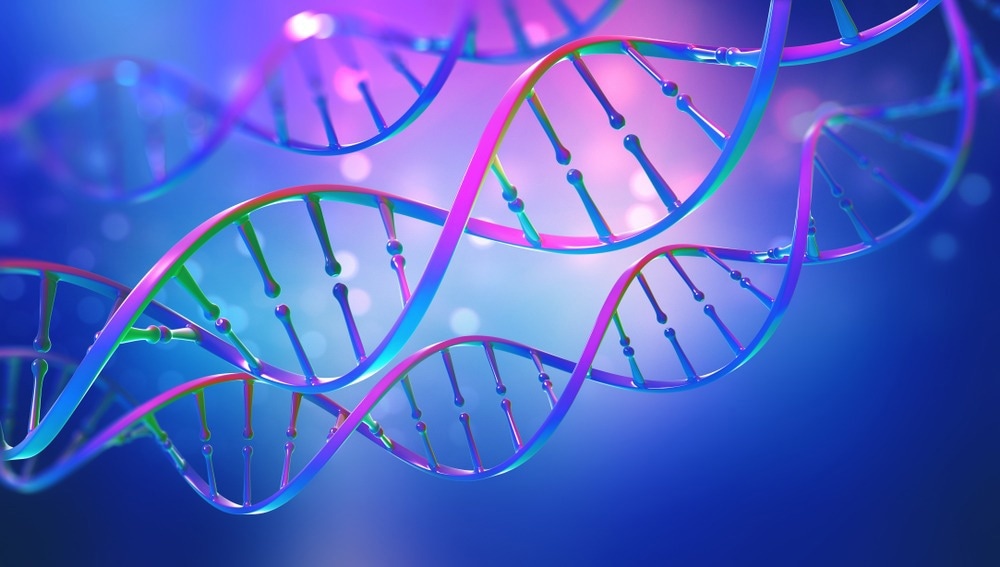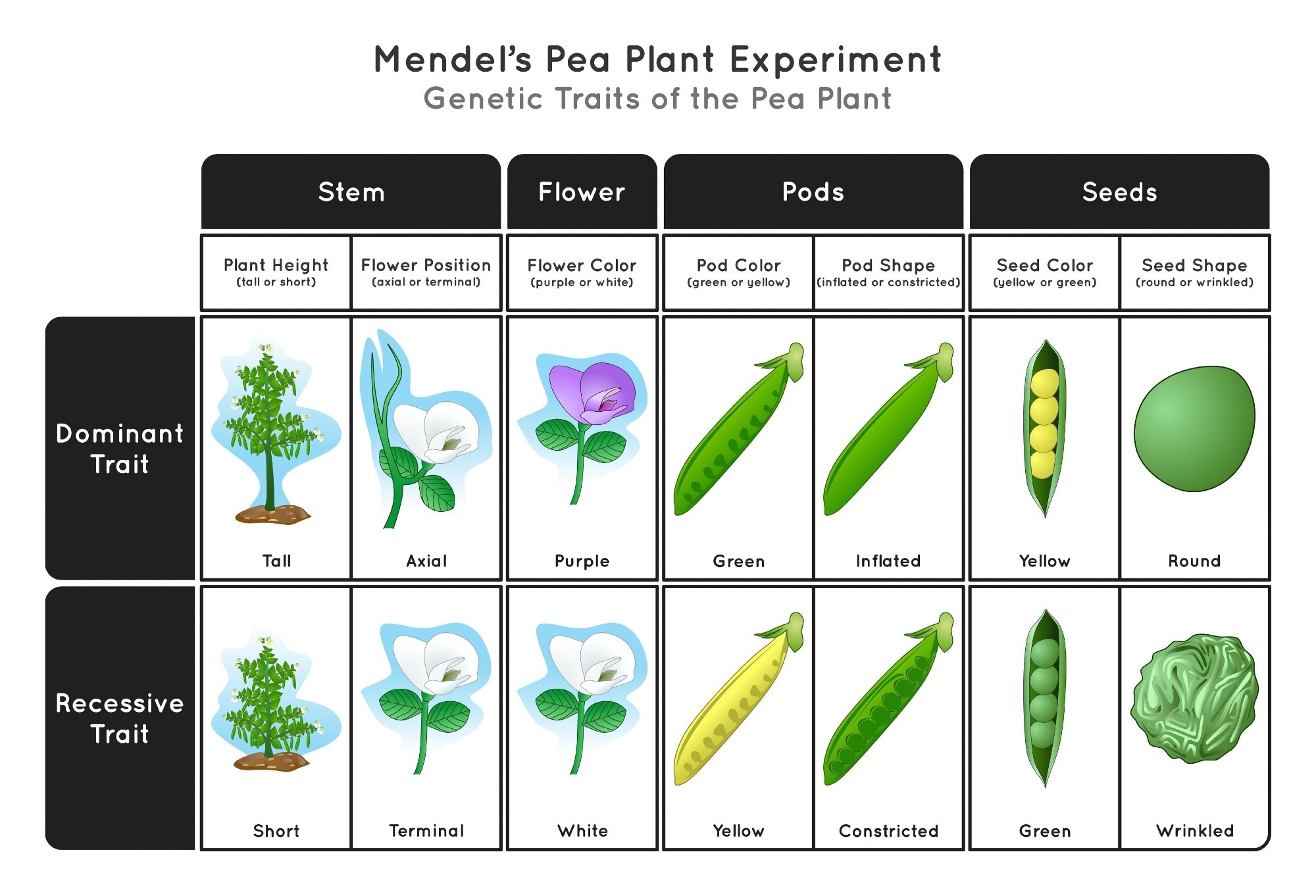Born off the back of Gregor Mendel’s work, the scientific discipline of genetics is often regarded as beginning with the publication of Mendel’s memoir on plant hybridization in 1866. His work inspired an outburst of research in the 20th century, with the term ‘genetics’ finding its origins in the early 1900s. However, the practice of selective breeding is centuries old and demonstrates an early understanding of inheritable traits.

DNA. Image Credit: Yurchanka Siarhei/Shutterstock.com
The Origins of Selective Breeding
Selective breeding, or the artificial selection of organisms with desirable phenotypes, is a practice that has helped shape modern dog breeds over millennia. Dating back over 30,000 years when ancient populations in East Asia began to work alongside wild wolves, the domestication and trait selection of more docile individuals began the journey for what would become “mankind's best friend”.
While there is little to indicate these populations understood the concept of genetics and manipulating genotypes, the people of East Asia and Southwest Asia demonstrated an early knowledge of artificial selection. Evidence from archaeological sites demonstrated how these groups were able to select and mate organisms, intending to combine and propagate desirable traits through the offspring.
Genetics in Modern History
By the turn of the 18th century, still without knowledge of genetics, Sir Robert Bakewell (1725 – 1795) pioneered selective breeding of livestock in the United Kingdom. By documenting the performance of livestock, Bakewell was able to select individuals harboring desirable traits and “fix” undesirable characteristics with inbreeding. In this way, Bakewell introduced the New Leicester sheep as well as the Leicestershire Longhorn cattle.
With the popularization of selective breeding, came a need for recording the growing number of generations in each pedigree. Herdbooks containing the pedigrees of livestock performing well were seen from across parts of Europe in the late 18th and early 19th centuries. By the end of the 1800s, herdbooks became a common practice in animal breeding.
Around this time, Swiss chemist Johann Friedrich Miescher first identified DNA and Austrian monk Gregor Mendel also began his work studying the mechanisms of heredity in garden peas (Pisum sativum L.). By selectively breeding and studying the traits of approximately 28,000 pea plants, Mendel was able to systematically record how visible traits passed from one generation to the next. Noticing a pattern in the features he studied, Mendel proposed three mathematical formulae to explain the inheritance of characteristics.
The Rediscovery of Mendelian Genetics
While at the time Mendel’s work was not widely accepted, nearly 40 years after its publication, four scientists across Europe independently rediscovered his laws of inheritance. One of them was English biologist William Bateson, who discovered Mendel’s work and began to experimentally corroborate his principles.
Bateson’s published work would demonstrate the translation of Mendel’s principles from plants into animals. His publications would also introduce key terminology to the field, including ’homozygote’ and ‘heterozygote’. In 1905, Bateson wrote to Cambridge professor Adam Sedgwick, proposing the term ‘genetics’ for the study of heredity.
Alongside Reginald C. Punnett and Edith Rebecca Saunders, Bateson also demonstrated a phenomenon that would come to be called linkage. Observing a deviation from the predicted Mendelian independent assortment, Bateson and colleagues proposed coupling of alleles such that certain traits are linked.
In 1909, Thomas Hunt Morgan began studying the fruit fly, Drosophila melanogaster. Proposing a linkage between the inheritance of eye color and sex in fruit flies, his work demonstrated the phenomenon. Coupling Mendelian genetics and the chromosomal theory, Morgan would go on to suggest that linked genes do not assort independently due to proximity on the same chromosome. Published in 1915, Morgan’s book “Mechanism of Mendelian Heredity” would expand on his theory of the linear arrangement of the genes in the chromosomes.

Mendelian genetics. Image Credit: udaix/Shutterstock.com
Determining the Carriers of Heredity
In the shadow of the 1918 flu epidemic, English microbiologist Frederick Griffith began studying strains of Streptococcus pneumoniae with dramatically varying appearance and virulence. Publishing his results in 1928, Griffith’s work demonstrated the ability of a chemical component (or “transforming principle”) to survive the heat and transform the phenotype of the recipient strain into the donor, a process that would come to be known as transformation.
Around the same time as Griffith, Oswald Avery and his colleagues were analyzing pneumococcal cell capsules. Following the publication of Griffith’s work, Avery’s lab began to focus on identifying the transforming principle in pneumococci. By 1944 the work of Avery and his colleagues was published, demonstrating that enzymatic destruction of DNA would prevent the transformation of recipient strains; supporting the belief that DNA carried the transforming principle.
The Structure and Function of DNA
While Avery’s work was not initially well-received, Erwin Chargaff championed his work and began to consider the chemical structure of the DNA. Utilizing Levene's "polynucleotide" model of DNA structure, Chargaff proposed a rule of pairing between the ratio of purines and pyrimidines (A = T and C = G).
Shortly after the publication of Chargaff’s work, in 1952 Alfred Hershey and Martha Chase conducted a series of experiments confirming DNA as the hereditary material. A year later, James Watson and Francis Crick utilized Chargaff’s rules, in combination with X-ray crystallography work by Rosalind Franklin and Maurice Wilkins, to help inform their three-dimensional, double-helical model of DNA.
In 1958, Francis Crick also proposed a central dogma of molecular biology to explain the transfer of genetic information from DNA to RNA and from RNA to proteins. Expanding on this, Marshall Nirenberg, Har Khorana, Severo Ochoa, and their colleagues determined how the nucleotide sequence encodes for amino acids.
Now equipped with the knowledge of DNA’s structure and function, research in the field of genetics flourished. By the 1970s, the first generation of DNA sequencing techniques was being developed, and by 1990 the Human Genome Project was established, along with a working group to determine the ethical, legal, and social implications of mapping and sequencing the human genome. Achieving its goal in 2003, the project successfully sequenced the entire genome; that same year the NIH National Human Genome Research Institute (NHGRI) launched a research effort to identify the functional elements in human DNA.
Clinical Applications of Genetics
As research in the field of genetics continues to expand, the role of DNA in human health and disease is slowly being elucidated. Pharmacogenomics and precision medicine plans utilize genetic variations or markers to determine predispositions to disease and efficacious treatment options. As artificial intelligence and machine learning advance, the ability of these tools to accurately predict responses to drugs and appropriate health care plans will improve.
Sources
- Graaf, A. (2014). Textbook Animal Breeding and Genetics [Online]. Groen Kennisnet. Available at: https://wiki.groenkennisnet.nl/ (Accessed on 4 January 2022).
- Gregor Mendel: the ‘father of genetics’ [Online]. John Innes Centre. Available at: www.jic.ac.uk/.../ (Accessed on 4 January 2022).
- Lobo, I. & Shaw, K. (2008) Discovery and types of genetic linkage. Nature Education 1(1):139.
- Pray, L. (2008) Discovery of DNA structure and function: Watson and Crick. Nature Education 1(1):100.
- O'Connor, C. (2008) Isolating hereditary material: Frederick Griffith, Oswald Avery, Alfred Hershey, and Martha Chase. Nature Education 1(1):105.
- What is the 'Central Dogma’? [Online]. Available at: https://www.yourgenome.org/facts/what-is-the-central-dogma. (Accessed on 4 January 2022).
- Human Genome Project Timeline of Events. [Online]. National Human Genome Research Institute. Available at: https://www.genome.gov/human-genome-project/Timeline-of-Events (Accessed on 4 January 2022).
- Human Genome Project Timeline. [Online]. Human Genome Project Information Archive 1990–2003 Available at: https://www.genome.gov/human-genome-project/Timeline-of-Events (Accessed on 4 January 2022).
Further Reading